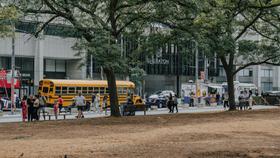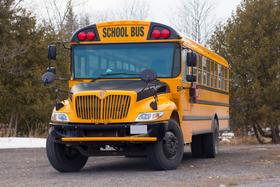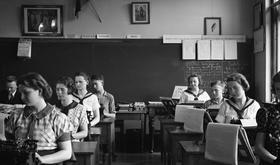North Carolina is the #9 largest school system in the United States, serving 1,546,447 students across the 2,761 public schools for the 2025-26 school year (there are 863 private schools, serving 135,232 students). 92% of all K-12 students in North Carolina attend public schools, compared to the national average of 90%.
The percentage of students achieving math proficiency in North Carolina is 51%. The percentage of students achieving reading proficiency is 50%.
The top-ranked public schools in North Carolina are Brown Summit Middle School, Metrolina Reg Scholars Academy, and Highland Sch Of Technology. Overall testing rank is based on a school's combined math and reading proficiency test scores.
Minority enrollment is 57%, with the majority being Black or Hispanic and the student-teacher ratio is 15:1.
Top Ranked Public Schools in North Carolina (2025-26)
School
(Math and Reading Proficiency)
(Math and Reading Proficiency)
Student Proficiency
Grades
Location
Rank: #11.
Brown Summit Middle School
Magnet School
(Math: ≥99% | Reading: ≥99%)
Rank:
Rank:
10/
Top 1%10
Math: ≥99% (Top 1%)
Reading: ≥99% (Top 1%)
Grades: 6-8
4720 Nc Highway 150 East
Browns Summit, NC 27214
(336) 656-0432
Browns Summit, NC 27214
(336) 656-0432
Rank: #22.
Metrolina Reg Scholars Academy
Charter School
(Math: 98% | Reading: 98%)
Rank:
Rank:
10/
Top 1%10
Math: 98% (Top 1%)
Reading: 98% (Top 1%)
Grades: K-8
5225 Seventy-seven Center Dr
Charlotte, NC 28217
(704) 503-1112
Charlotte, NC 28217
(704) 503-1112
Rank: #3 - 53. - 5.
Highland Sch Of Technology
Magnet School
(Math: ≥95% | Reading: ≥95%)
Rank:
Rank:
10/
Top 1%10
Math: ≥95% (Top 1%)
Reading: ≥95% (Top 1%)
Grades: 9-12
1600 N Morris Street
Gastonia, NC 28052
(704) 810-8816
Gastonia, NC 28052
(704) 810-8816
Rank: #3 - 53. - 5.
Nesbitt Discovery Academy
(Math: ≥95% | Reading: ≥95%)
Rank:
Rank:
10/
Top 1%10
Math: ≥95% (Top 1%)
Reading: ≥95% (Top 1%)
Grades: 9-12
175 Bingham Rd Ste 10
Asheville, NC 28806
(828) 271-4521
Asheville, NC 28806
(828) 271-4521
Rank: #3 - 53. - 5.
Quest Academy
Charter School
(Math: ≥95% | Reading: ≥95%)
Rank:
Rank:
10/
Top 1%10
Math: ≥95% (Top 1%)
Reading: ≥95% (Top 1%)
Grades: K-8
10908 Strickland Road
Raleigh, NC 27615
(919) 841-0441
Raleigh, NC 27615
(919) 841-0441
Rank: #66.
White Oak Elementary School
(Math: 96% | Reading: 92%)
Rank:
Rank:
10/
Top 1%10
Math: 96% (Top 1%)
Reading: 92% (Top 1%)
Grades: PK-5
1512 White Oak Church Rd
Apex, NC 27523
(919) 694-0202
Apex, NC 27523
(919) 694-0202
Rank: #7 - 87. - 8.
Central Academy Of Technology And Arts
(Math: ≥95% | Reading: 90-94%)
Rank:
Rank:
10/
Top 1%10
Math: ≥95% (Top 1%)
Reading: 90-94% (Top 1%)
Grades: 9-12
600 Brewer Dr
Monroe, NC 28112
(704) 296-3088
Monroe, NC 28112
(704) 296-3088
Rank: #7 - 87. - 8.
Rockingham Co Early College High School
(Math: ≥95% | Reading: 90-94%)
Rank:
Rank:
10/
Top 1%10
Math: ≥95% (Top 1%)
Reading: 90-94% (Top 1%)
Grades: 9-13
215 Wrenn Memorial Road
Wentworth, NC 27375
(336) 342-4261
Wentworth, NC 27375
(336) 342-4261
Rank: #9 - 109. - 10.
Raleigh Charter High School
Charter School
(Math: 90-94% | Reading: ≥95%)
Rank:
Rank:
10/
Top 1%10
Math: 90-94% (Top 1%)
Reading: ≥95% (Top 1%)
Grades: 9-12
1307 Glenwood Avenue
Raleigh, NC 27605
(919) 715-1155
Raleigh, NC 27605
(919) 715-1155
Rank: #9 - 109. - 10.
Union County Early College
(Math: 90-94% | Reading: ≥95%)
Rank:
Rank:
10/
Top 1%10
Math: 90-94% (Top 1%)
Reading: ≥95% (Top 1%)
Grades: 9-13
4209a Old Charlotte Hwy
Monroe, NC 28110
(704) 290-1565
Monroe, NC 28110
(704) 290-1565
Overview
This State (NC)
# Schools
2,761 Schools
# Students
1,546,447 Students
Gender %
# Teachers
100,041 Teachers
Student-Teacher Ratio
15:1
Student By Grade
State Acdeamy
State Average (NC)
Math Test Scores (% Proficient)
(21-22)51%
Reading/Language Arts Test Scores (% Proficient)
(21-22)50%
Science Test Scores (% Proficient)
(21-22)63%
Graduation Rate
(21-22)86%
Eligible for Free Lunch
68%
Eligible for Reduced Lunch
1%
Students by Ethnicity:
Diversity Score
0.71
# American Indian Students
16,970 Students
% American Indian Students
1%
# Asian Students
65,130 Students
% Asian Students
4%
# Hispanic Students
326,835 Students
% Hispanic Students
21%
# Black Students
379,923 Students
% Black Students
25%
# White Students
665,079 Students
% White Students
43%
# Hawaiian Students
2,147 Students
% Hawaiian Students
n/a
# Two or more races Students
92,134 Students
% of Two or more races Students
6%
All Ethnic Groups
State Revenue and Spending
This State (NC)
Total Revenue
$17,307 MM
Spending
$17,964 MM
Revenue / Student
$11,191
Spending / Student
$11,616
Best North Carolina Public Schools by County (2025-26)
Popular neighborhoods: North Raleigh (18 schools), Douglas Byrd (15 schools), Downtown (13 schools), Terry Sanford (12 schools), Northeast Raleigh (12 schools).
County
# Schools
# Students
% Minority
Frequently Asked Questions
What are the top ranked public schools in North Carolina?
The top-ranked public schools in North Carolina include Brown Summit Middle School, Metrolina Reg Scholars Academy, and Highland Sch Of Technology.
How many public schools are located in North Carolina?
2,761 public schools are located in North Carolina.
What percentage of students in North Carolina go to public school?
92% of all K-12 students in North Carolina attend public schools (compared to the national average of 90%).
What is the racial composition of students in North Carolina?
Minority enrollment in North Carolina is 57%, with the majority being Black or Hispanic.
Which public schools in North Carolina are often viewed compared to one another?
Popular comparisons of public schools in North Carolina include: Anson Co. Early College High School vs. Anson High School, Robbinsville Middle School vs. Robbinsville High School, Nc Virtual Academy vs. North Carolina Cyber Academy
Recent Articles

10 Major Challenges Facing Public Schools in 2025
Explore the 10 biggest challenges facing U.S. public schools in 2025, from funding shortages to mental health and technology gaps.

Broward County School Bus Service Update 2025
A 2025 review of Broward County public school bus service: challenges, innovations, and what parents should know.

Failures of U.S. Public Education in 2025
Explore the 15 biggest failures of the American public education system in 2025, with updated data, expert insights, and real-world examples.





